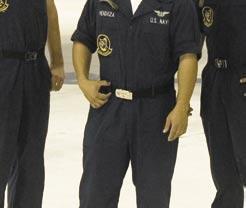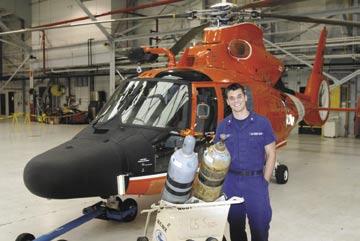
8 minute read
Bravo Zulu
from MECH Fall 2007
Send BZs to: SAFE-Mech@navy.mil

Advertisement



BZ Quarter of the
AD3 Ferdinand Mendoza, AD3 Robert Wilson, and ADAA Zechariah Edwards VP-47



While preparing for a high-power turn at Marine Corps Air Facility, Kaneohe Bay, Hawaii, Petty Officers Mendoza and Wilson, along with Airman Apprentice Edwards, noticed another aircraft begin to move without any people on board. The aircraft was pivoting around its chocked port landing gear because of unexpected high winds.
Without delay, these three Sailors took control and directed nearby personnel to chock the aircraft, ensuring the security of all other aircraft on the line.
Petty Officer Willcutt, USCG ATC Mobile, AL
Petty Officer Willcutt was preparing to service the MLG tires on an HH-65C and went to retrieve a nitrogen-servicing cart. Approaching the unit, he noticed the bottles were different colors. Further inspection revealed the bottles were filled with Argon. He then notified all hangar supervisors, and they immediately grounded all helos. Numerous aircraft were cleaned and re-serviced to make sure they were serviced with the right agent, preventing a certain catastrophe.

AOAN D’Lane Zimmerman VFA-83
Airman Zimmerman saw the port engine exhaust of RAM 300 blowing on live ordnance loaded on RAM 310. He immediately signaled this problem to the squadron ordnance officer and placed himself between the engine exhaust and ordnance to minimize the hazard until RAM 300 was moved.
Airman Zimmerman’s selfless action prevented an ordnance mishap that could have resulted in damage to critical weapon parts or possibly a flight-deck catastrophe. GySgt. Alexander Marshall and SSgt. Jeffrey Anderson VMA-513

While screening the logbook during an acceptance inspection of an AV-8B Harrier, GySgt. Marshall and SSgt. Anderson discovered an apparent discrepancy in the assembly service record for the aircraft’s engine. The time-since-new entry for the low-pressure compressor 1/2 disc didn’t seem correct. After researching the logs back to 1997 and making phone calls to both the fleet-support team and the IMA, they confirmed a transcription error dating back more than three years. The actual time on the component was more than twice that recorded in the logs, and the item was well beyond the approved service limit, threatening the safety of the aircraft and aircrew.
AO3 Rebecca Alicea VFA-83
Before RAM 303 could be launched, Petty Officer Alicea saw a fairing was cracked on starboard station No. 5. Recognizing the severity of this FOD hazard, she immediately notified maintenance control. The piece was removed, preventing a FOD incident and severe damage. Her swift action allowed the aircraft to make the launch.
AM2(AW) Stephen Warrick HSL-42
While doing a 56-Day special inspection on Proud Warrior 432, an SH-60B helicopter, Petty Officer Warrick found a broken guide-wire tube for the tail rotor at a mounting bracket along the tail pylon. The tube also was broken in two more spots: in an obstructed location beneath a stabilator actuator bolt and within the hysol bonding material at another bracket. This tubing protects the tail rotor’s control cables from damage as they run up the tail pylon. Had this serious problem gone unnoticed, it could have led to dangerous chafing of the tail-rotor control cables, jeopardizing flight safety.
AM2 Warrick is a hard-charging, devoted structural mechanic. His diligence and professional knowledge led to a one-day turn around of PW432 following the delivery of the new tubing. His attention to detail
prevented a possible serious mishap. Airman Linda Meale VFA-143
A qualified Hornet PC, Airman Meale was overseeing the recovery of Dog 114. She was observing a plane-captain trainee, who just had arrived on the flight deck two days earlier from four months of galley duty. After Dog 114 was recovered, the yellowshirts signaled for a push back, which involves all hands pushing the aircraft backward into final position. This step was done while its engines still were turning.
The plane-captain trainee proceeded toward the port intake for the push back. Airman Meale, without hesitation, reached out and grabbed the trainee just before he reached the critical hazard area in front of the intake. The trainee was shaken and extremely appreciative of her efforts. AMEAN Richard English VAQ-142
While completing a daily turnaround inspection on aircraft 520, AMEAN English found smoke coming from the California Shelter on the EA-6B flight line at Bagram Air Base. He immediately informed the line division chief petty officer and began searching for the cause of the smoke. He quickly found the newly installed heater was overheating. It had melted the ducting tube, which connected the heater. He set a fire watch until the fire department arrived.
AM1 John Killian VP-5
While working on a periodic inspection of the PATRONSIG hangar, Petty Officer Killian found several serious fire-safety-related discrepancies. One fire-bottle was missing, the fire bottle for the
geedunk was found under a coffee machine and had an overdue inspection, another bottle wasn’t attached to the bulkhead, and the automatic system inside the hazmat locker had not been inspected since 2000.
Petty Officer Killian’s finds caused a full inspection of the hangar, which led to even more discrepancies.
AM2(AW) Christopher Nadeau VP-26
During a pre-flight of a visiting P3C from VP-40, Petty Officer Nadeau was called on to verify a leaking brake-accumulator fitting in the hydraulic service center. Using the 18-inch rule, he continued to inspect the hydraulic service center for more hydraulic leaks. He found the turn barrel for the autopilot-emergency disconnect cable unsecured and backing off. Had this discrepancy gone undetected, the turn barrel would have separated, disabling the autopilot-emergency disconnect system and causing loss of flight control.
Petty Officer Nadeau immediately notified maintenance control and his supervisor. The discrepancy was fixed and the aircraft returned to FMC status. AD2 John Tipton VR-56
After air-traffic control reported seeing an unknown fluid venting from the port engine during takeoff, Petty Officer Tipton adeptly performed all published maintenance procedures. When he did not find the source of the problem, he tenaciously continued investigating and eventually determined vaporized fuel was the unknown fluid. Tests later proved that fuel had leaked into the oil system, which could have caused an engine failure. He found a leak in the fuel-oil cooler; oil was being diluted by fuel.
AD3 Danny Hansen VAW-113
During the first day of CVW-14 carrier qualifications, Petty Officer Hansen’s quick actions prevented significant damage to a $90-milliondollar E-2C Hawkeye 2000 aircraft. He also prevented potentially serious injury to flight-deck personnel.
He was a troubleshooter and part of the E-2C safety chain around the propellers of Black Eagle 600. He noticed a fastener laying on the flight deck a few inches below the spinning starboard propeller. He immediately alerted the flight-deck coordinator, who signaled the aircrew to secure the starboard engine.
After verifying the fastener had not come from Black Eagle 600, the starboard engine quickly was restarted, allowing the squadron to expeditiously complete its carrierqualification requirements.
AD3 Paul Ciaramella VP-26
While inspecting an engine nacelle on a P-3 ISIS “C,” Petty Officer Ciaramella found a 7/16 hex nut jamming the linkage-control rods for the power levers. He immediately notified the ISIS coordinator and his work-center LPO. The FOD was removed, and another look revealed no discrepancies.
Had the easy-to-overlook nut not been discovered, it could have led to a loss of engine-power control and subsequent loss of the aircraft.

SSgt. Stull was working on a QA-required task during a phase inspection on a CH-53E. Outside an area of his normal scan, he found the No. 6 hanger bearing for the tail drive shaft moved freely within the damper housing.
Investigating more closely, SSgt. Stull found the wrong damper housing had been used. If ignored, this discrepancy would have led to the loss of aircraft and possibly aircrew. AMEAN Adam Friend VFA-213
During an aircraft launch, Airman Friend was doing final-checker training on Blacklion 205 and noticed a ball bearing was missing from the pin holding the hydraulic hand pump that services the auxiliary pump unit (APU). In this situation, the metal hand pump, which is approximately 2-feet long and located in the right main-landing-gear door, easily could have dislodged. The hand pump could have caused disastrous damage to the landing gear and hydraulic lines; it also could have FODed the engine. ADAN Linus Dias HSL-48 Det. 7
During a daily inspection on Venom 510 aboard USS Hue City (CG-66), Airman Dias discovered the retaining bracket for the LDS cable on the No. 2 engine was broken. Had this discrepancy gone unnoticed, it may have resulted in loss of No. 2 engine control or caused flight-control binding, endangering the aircraft and aircrew.
AM2(AW) Clifford Grambo HSL-48 Det. 7
While inspecting hydraulic lines on Venom 511 during an aircraft phase A inspection, Petty Officer Grambo discovered that the return line for No. 1 tail rotor servo was chafed. It was rubbing against an adjacent hydraulic line and threatened flight safety.
Petty Officer Grambo worked tirelessly for 10 hours to remove the line and to measure the degree of chafing before determining it was
SSgt. Stephen Stull HMH-772
out of limits.
LCpl. Armando AnchondoVillegas H&HS Yuma
While doing a “B” Phase inspection of the flight controls on an HH-1N helicopter, LCpl. AnchondoVillegas found a 3-inch crack on the pylon-support attachment, parallel to the servo-actuator mount. These mounts are essential in stability of the aircraft’s flight-control system. This crack was difficult to see and was an extraordinary find. His attention to detail and extra effort highlighted a serious problem in a critical part of the airframe, which could have led to a serious mishap.










